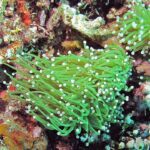Sarcophyton, often called sarco, is the star of the soft corals, also known as leather corals. This type of coral belongs to the Octocorallia family and is made up of several species of soft coral. After many hours of analysis, we tell you all about it.
All the characteristics of Sarcophyton
What does Sarcophyton look like?
As I said in my introduction, the Sarcophyton family includes several species of leather coral , each with their own specific characteristics, but all with many similarities. The first thing that makes them easily recognizable is their mushroom-like shape, which is how they got their name. As for their size, it varies enormously according to their gender. Adult males can reach 11 cm in diameter, while females can exceed 60 cm. As for their height, the largest can measure several dozen centimetres.
Depending on the species, they therefore have different shapes and colors. To give you a precise description of one of them, the Sarcophyton Glacum, which is certainly the best known, has long polyps with a green tip and brown or even yellow flesh.



Where do sarcos come from?
The majority of these leather corals are found in reefs from the western Pacific Ocean to Polynesia and the Red Sea.
How do you incorporate Sarcophyton into your aquarium?
How much does a Sarcophyton cost?
Prices vary widely according to species and size. The least expensive, such as Brown Sp or Elegans, can be found for less than €20, or even less than €15 in some cases. Prices for soft corals can exceed 80€ for species such as Latum or Lobatum.
Aquarium and water type
Location
No matter, but not too close to other corals.
Aquarium size
Your aquarium should have a volume of over 200 liters.
Lighting
It needs powerful lighting with a Par value of 250 to 400 µmol/m²/s.
Calcium and magnesium
Magnesium should be between 1100 and 1250 mg/l and calcium between 350 and 400 mg/l.
How to care for your Sarcophyton?
Sarcos are very easy to maintain and suitable for beginners, but there are a few rules to be observed. They need powerful T8 or T5 lighting . You also need to stir the water vigorously enough to allow them to release their mucus. If all these rules are followed, the Sarco can grow impressively , in some cases exceeding 40 to 50 cm even in an aquarium.
What you need to know before adding it to your aquarium
These soft corals produce more toxic compounds than most leather corals. It is therefore important to be careful when handling them. They can also be harmful to other corals in your aquarium. It is therefore not advisable to add it to your aquarium if you already have the following coral species: Catalaphyllia, Plerogyra and Euphyllia. In fact, it can kill all three coral species, and is also very bad for the majority of Acropora coral species.
Sarco can replace an anemone for a couple of clownfish. These fish are less accustomed to its corals, but this will prevent your anemone from burning your other corals.




